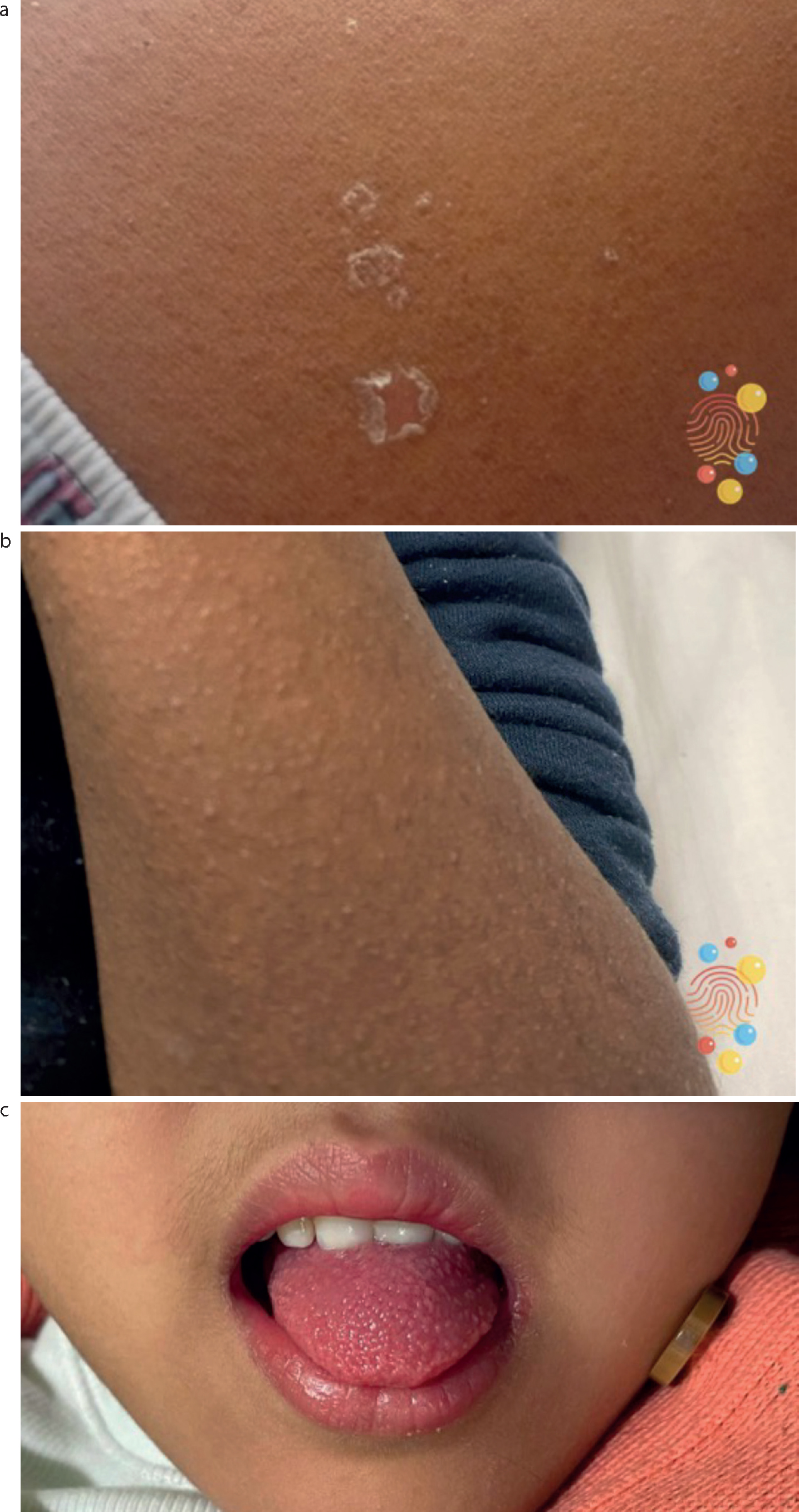Abstract
Scarlet fever is a mild, but highly contagious disease caused by Group A
From Volume 50, Issue 2, February 2023 | Pages 142-145
Scarlet fever is a mild, but highly contagious disease caused by Group A

Scarlet fever is mild but highly contagious disease caused by Group A Streptococcus (GAS) bacteria.1 This group of bacteria can cause a wide range of skin, soft tissue, and respiratory tract infections ranging from mild to life-threatening.1 The most serious infections linked to GAS come from invasive GAS, known as iGAS. iGAS infections occur when bacteria move to a part of the body in which they are not normally found, such as the blood stream, and in some rare cases, iGAS infections can be fatal.2 Children with viral infections, such as varicella (chickenpox) and influenza, are at a higher risk of developing iGAS disease.3 Data from the UK Health Security Agency (UKHSA) published in December 2022 reported an out-of-season increase in scarlet fever and iGAS infections.4 The report stated that between September and December 2022 there were 7750 notifications of scarlet fever reported.4 This compares to a total of 2538 at the same point in the year during a comparably high season in 2017-2018.4
An increased number of iGAS infections has also been reported in the US. In November 2022, the US Centers for Disease Control and Prevention (CDC) were notified of a probable increase in iGAS infections among children in a hospital in Colorado.5 Within a few weeks, increased iGAS infections were reported in other states, including Minnesota and Pennsylvania.6 The CDC issued a nationwide health alert to clinical staff and public health authorities to highlight the recent increase in iGAS infections among children in the US in December 2022.5 The World Health Organization (WHO) also reported in December that since September there had been an increase in the number of iGAS cases among children under 10 in several European countries, including France, Ireland, the Netherlands, Sweden and the UK.3 In Ireland, the Health Protection Surveillance Centre reported that between September and December 2022, 23 iGAS infections were recorded compared to 11 cases for the same period in 2019, showing a two-fold increase in iGAS infection numbers.7 The WHO stated that several deaths associated with iGAS disease in children under the age of 10 years were reported from France, Ireland and the UK.3
There is no clear explanation for why cases of scarlet fever and iGAS are higher than expected in 2022/2023. It has been suggested that the increase in infections may be due to the lack of exposure to GAS bacteria during the COVID-19 lockdown resulting in children having a poorer immunity to the bacteria.8 It has also been suggested that the increase in cases of iGAS disease in children may be associated with the recent increased circulation of respiratory viruses, such as seasonal influenza, because co-infection with viruses may increase the risk of iGAS disease.3 WHO announced that reducing the transmission of GAS bacteria will help to reduce the risk of severe iGAS infection.3 As healthcare professionals, the dental team should be aware of the key aspects of scarlet fever in relation to dentistry. The clinical features of scarlet fever, along with symptoms, transmission, oro-facial manifestations, impact on local antibiotic supply, and risks for the dental team, are discussed below.
Scarlet fever is highly contagious and is spread by close contact with someone carrying the bacteria.9 It takes approximately 2-5 days to develop symptoms after exposure; however, the incubation period can vary between 1 and 7 days.9 An individual with scarlet fever is considered infectious up to 6 days before their symptoms start, until 24 hours after their first dose of antibiotics.9 The main features of this infection are outlined in Table 1.
| Agent | Group A Streptococcus |
| Spread | Close contact, direct skin contact, contaminated objects, and respiratory droplets |
| Symptoms | Sore throat, headache, fever, nausea, fatigue and vomiting |
| Symptom duration | Approximately 1 week, but this can vary |
| Rash characteristics | Fine red rash on chest and stomach, rapidly spreading to other parts of the body, feels like sandpaper to touch |
| Oral manifestations | White coating on the tongue which peels a few days later, leaving the tongue looking red and swollen (known as ‘strawberry tongue’) |
| Treatment | 10 day course of antibiotics (main recommendation is Penicillin V) |
| Isolation | For first 24 hours of appropriate antibiotic treatment |
| Prevention | Wash hands often, do not share eating utensils/cups/towels with an infected person, carefully wash or dispose of tissues/objects contaminated by an infected person |
| Complications | Small risk of ear infection, throat abscess, cellulitis, septicaemia, and meningitis |
Within the first 12-48 hours of scarlet fever symptoms, it is common for a rash to develop on the chest/tummy, which then spreads. The rash can appear like raised small bumps and feel rough like sandpaper (Figure 1a,b). It is common practice for doctors to diagnose scarlet fever from clinical symptoms alone. If confirmation is required, a throat swab can be sent for bacterial culture.10 Scarlet fever is not considered to be serious and can be treated with antibiotics. First-line treatment for suspected scarlet fever infection is penicillin V.11 For patients with a penicillin allergy, clarithromycin or erythromycin are recommended.11 Antibiotic treatment for scarlet fever is reported to reduce a patient's chance of developing an iGAS infection and reduce the risk of spreading the infection to others.1 Current NHS guidance advises ‘that children should not return to nursery or school, and adults to work, until a minimum of 24 hours after starting antibiotic treatment’.9 It is known that if a patient with scarlet fever is not treated with antibiotics, they can be contagious for 2-3 weeks after their symptoms resolve, so it is important that patients with this condition are identified and treated early.1
It is known that individuals with scarlet fever can develop ‘strawberry tongue’ (Figure 1c).1 This is a condition whereby the tongue can become red, bumpy, swollen and resemble a strawberry. The tongue may also become white for a few days before turning red. It is possible that a patient or a concerned parent may try to access a dentist for an opinion on this oral manifestation. It is likely that individuals with strawberry tongue will also have other symptoms of scarlet fever, so it would be prudent to carry out a remote consultation via video or telephone to gather information on the patient's symptoms. Scarlet fever responds well to antibiotics, and strawberry tongue is likely to resolve with the correct treatment.1 The dental team should have a plan on how best to manage a patient presenting with this oral manifestation. The plan should include reassurance that this manifestation is common with scarlet fever, along with advice for the patient, family and close contacts on how to reduce the spread of the infection. Dentists should emphasize the importance of antibiotic treatment in scarlet fever patients in reducing the chance of developing an iGAS infection and the risk of spreading the infection to others.1
Penicillin V and amoxicillin are commonly prescribed by dentists in the UK for dental infections. At the time of writing (December 2022), there was a shortage of penicillin V oral suspension and amoxicillin in some areas of the UK owing to the increased demand for penicillin-based antibiotics for children with suspected scarlet fever. It is important that dentists continue to prescribe antibiotics as per the evidence-based standard, but it is important to consider that some oral suspensions may not be available. It is also important for the dental team to be aware that they may be faced with a situation where there is no penicillinbased antibiotic in the local area, and so alternatives may need to be prescribed. It would be prudent for dentists to revise what second-line treatment is recommended should the first-line antibiotics be unavailable.

Dental clinics in the UK are known to adhere to strict infection control standards and implement universal infection control procedures (ICP) for all patients regardless of their infectious status. As such, it could be argued that infections, such as scarlet fever, do not pose a major threat to the dental team. Nevertheless, as dentistry requires prolonged close contact with patients, it is possible that GAS transmission could occur within a dental clinic. The dental team should have a strategic plan on how best to manage patients with scarlet fever who require dental treatment. It is important to emphasize that dentists should delay elective dental treatment in suspected cases of scarlet fever until such a time as the patient is no longer deemed infectious. Decisions on a patient's infectious status will need to be made on a case-by-case basis because it will depend on whether they are receiving an appropriate course of antibiotics. If there is any doubt about a patient's infectious status, advice should be sought from the local public health protection team and/or the patients general medical practitioner. If a patient with scarlet fever requires emergency dental treatment that cannot be delayed, the dental team should carry out a thorough medical history to check whether the patient is receiving appropriate antibiotic therapy. In this situation, it would be appropriate to consider liaising with the local public health protection team to ascertain whether special precautions, such as FFP3 respiratory masks, are required. As always, the recommended standard IPC precautions should be strictly adhered to.12 It is also important to consider keeping equipment within the surgery to a minimum to aid infection control.
At the time of writing, cases of scarlet fever are higher than expected in the UK, and the unusual seasonal pattern is likely to continue into 2023.4 All healthcare workers, including dentists, should remain vigilant and be prepared to manage patients who may present with orofacial symptoms of scarlet fever. Dentists play an important role in informing patients and families of the importance of antibiotic treatment for scarlet fever because it can reduce the chance of developing an iGAS infection and the risk of further spread of the infection.1